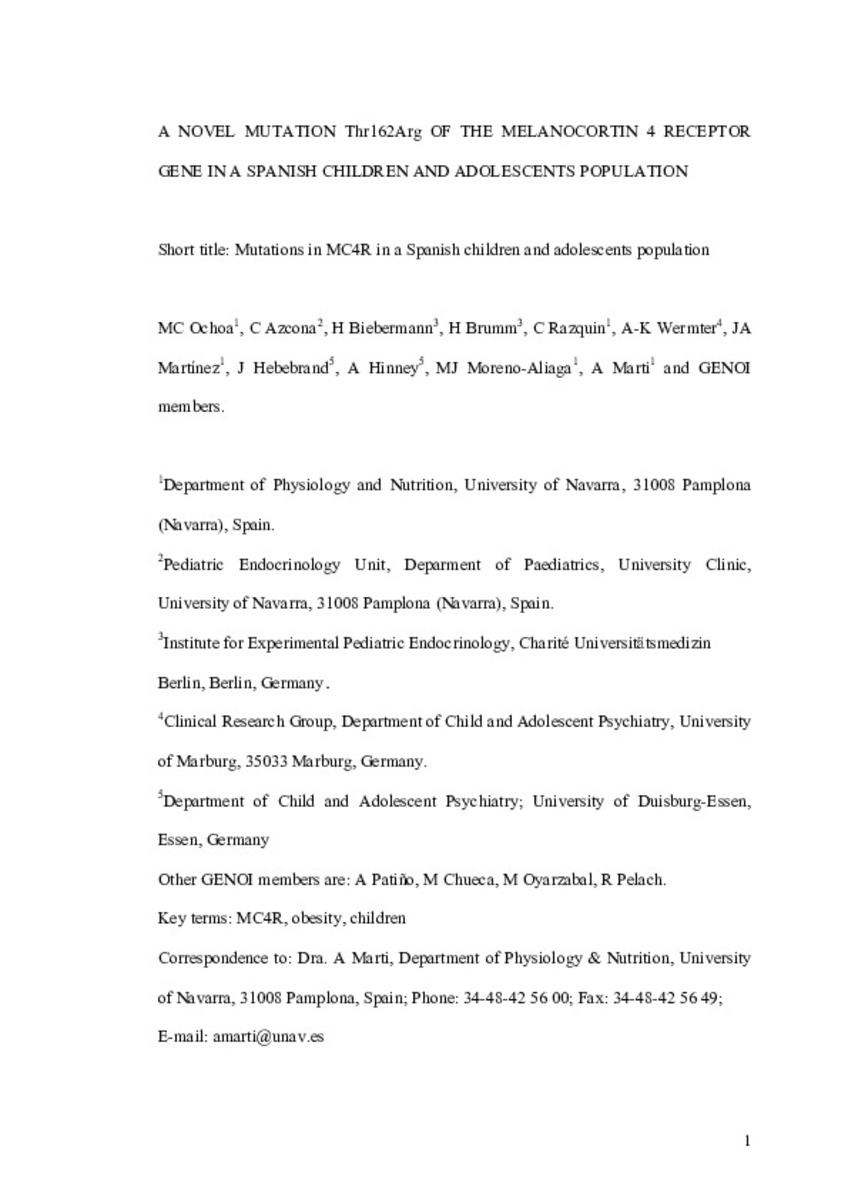Full metadata record
| DC Field | Value | Language |
|---|---|---|
| dc.creator | Ochoa, M.C. (María Carmen) | - |
| dc.creator | Azcona-San-Julian, M.C. (María Cristina) | - |
| dc.creator | Biebermann, H. (H.) | - |
| dc.creator | Brumm, H. (H.) | - |
| dc.creator | Razquin, C. (Cristina) | - |
| dc.creator | Wermter, A.K. (A.K.) | - |
| dc.creator | Martinez, J.A. (José Alfredo) | - |
| dc.creator | Hebebrand, J. (Joahnnes) | - |
| dc.creator | Hinney, A. (Anke) | - |
| dc.creator | Moreno-Aliaga, M. J. (María Jesús) | - |
| dc.creator | Marti-del-Moral, A. (Amelia) | - |
| dc.creator | Grupo de Estudio Navarro de la Obesidad Infantil (GENOI) | - |
| dc.date.accessioned | 2010-11-10T13:18:33Z | - |
| dc.date.available | 2010-11-10T13:18:33Z | - |
| dc.date.issued | 2007 | - |
| dc.identifier.citation | Ochoa MC, Azcona C, Biebermann H, Brumm H, Razquin C, Wermter A-K, et al. A novel mutation Thr162Arg of the melanocortin 4 receptor gene in a Spanish children and adolescent population. Clinical Endocrinology 2007; 66(5): 652-658. | es_ES |
| dc.identifier.issn | 0300-0664 | - |
| dc.identifier.uri | https://hdl.handle.net/10171/14081 | - |
| dc.description.abstract | Objective The melanocortin 4 receptor gene (MC4R) is involved in body weight regulation. While many studies associated MC4R mutations with childhood obesity, information on MC4R mutations in Spanish children and adolescents is lacking. Our objective was to screen a population of children and adolescents from the north of Spain (Navarra) for MC4R mutations and to study the phenotypes of carriers and their families. In addition, functional assays were performed for a novel MC4R mutation. Methods The study was composed of 451 Spanish children and adolescents (49% boys), aged 5–18 year. According to the International Obesity Task Force (IOTF) criteria, the groups included 160 obese, 132 overweight and 159 normal-weight control subjects. Results One novel (Thr162Arg) and three known nonsynonymous mutations in the MC4R gene (Ser30Phe, Thr150Ile, Ala244Glu) were detected heterozygously. The MC4R mutations were found in three male (one obese and two overweight) and two female subjects (one obese and one overweight). The novel mutation did not appear to lead to an impaired receptor function. An unequivocal relationship of MC4R mutations with obesity in pedigrees together with an impaired function of the encoded receptor could not be established for any of the mutations. Conclusions The presence of heterozygous MC4R mutations in obese and overweight subjects indicates that these mutations may be a susceptibility factor for obesity development, but lifestyle factors, such as exercise or sedentary activities, may modify their effect. | es_ES |
| dc.language.iso | eng | es_ES |
| dc.publisher | Wiley Blackwell | es_ES |
| dc.rights | info:eu-repo/semantics/openAccess | es_ES |
| dc.subject | Obesidad | es_ES |
| dc.subject | Melanocortin-4 receptor gene | es_ES |
| dc.subject | Proteinas | es_ES |
| dc.subject | Genes | es_ES |
| dc.subject | Adolescencia | es_ES |
| dc.title | A novel mutation Thr162Arg of the melanocortin 4 receptor gene in a Spanish children and adolescent population | es_ES |
| dc.title.alternative | Mutations in MC4R in a Spanish children and adolescents population | es_ES |
| dc.type | info:eu-repo/semantics/article | es_ES |
| dc.identifier.doi | http://dx.doi.org/10.1111/j.1365-2265.2007.02788.x | es_ES |
Files in This Item:
Statistics and impact
Items in Dadun are protected by copyright, with all rights reserved, unless otherwise indicated.






